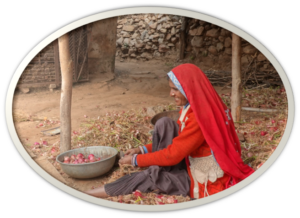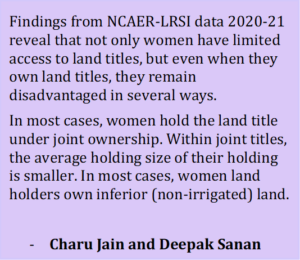
Dr Charu Jain (NCAER) and Mr. Deepak Sanan (Ex-Additional Chief Secretary of Himachal Pradesh)
Women play critical roles in agricultural operations, yet they have limited access, control, and ownership over the land. The Gender and Land Rights Database (GLRD) of the Food and Agriculture Organization (FAO, 2018) shows that the share of women agricultural landholders globally is less than 15 per cent. The Landesa report (2016) shows that in as many as 90 countries, customs inhibit women’s access to land. India’s story is very much in line with the international picture. As per Agriculture Census 2015-16, only 14 per cent of women were operational landholders in India, despite the fact that 73 per cent of rural women workers were engaged in the agriculture sector.
Broadly, women can acquire land through inheritance, gift, purchase, or government transfers, but as Agarwal (1998) mentions all these sources are structurally and operationally skewed against equal participation of women. Land possession through inheritance is most prominent, especially in South Asia, including India, but these provisions are often governed by religious laws which are not favourable towards women. Furthermore, prevailing patriarchal norms adversely affect the implementation of even progressive laws and policies on the ground, contributing to the dismal situation.
Evidence suggests that secure titles can increase women’s access to agricultural inputs such as credit and technology. This can both strengthen women economically, increase food security, and enhance farm productivity (Peterman et al., 2010; Goldstein, et al., 2015; Bezabih et al., 2016). Producing an updated database at regular intervals can at the very least enable an understanding of the distribution patterns and continuing inequities in landholding, and possibly encourage public policy discourse at securing equitable gender outcomes.
In this direction, using a sample of digital land record copies (12,208) for 12 States/UTs in India (extracted during NCAER’s Land Records and Services Index Study- N-LRSI 2020-21), we examine different dimensions of discrimination that women face in ownership of agricultural land in rural India. We also look at these facets in the context of the laws and provisions that attempt to improve the situation of women’s land rights in these states.
 The findings not only confirm that women have limited access to land titles but also bring out the fact that even when they own land titles, they remain disadvantaged in several ways. First, women rarely own land individually on their own. Individual ownership, documented through the proportion of land titles owned by women alone, ranges from as low as 4.5 per cent in Jharkhand to a high of merely 17 per cent in Maharashtra among the sample States (and reaching 25 per cent in the case of one of the Union Territories). In most cases, women hold the land title under joint ownership with men. Within joint titles, it is not just that fewer women hold titles within the same land parcel, but even when they own land, the share of land size held by women is also smaller compared to men. Further, a larger proportion of women landowners are found to own non-irrigated land which is not as productive as irrigated land. Even in cases where women own irrigated land, the average size of their holding is comparatively smaller than that of men.
The findings not only confirm that women have limited access to land titles but also bring out the fact that even when they own land titles, they remain disadvantaged in several ways. First, women rarely own land individually on their own. Individual ownership, documented through the proportion of land titles owned by women alone, ranges from as low as 4.5 per cent in Jharkhand to a high of merely 17 per cent in Maharashtra among the sample States (and reaching 25 per cent in the case of one of the Union Territories). In most cases, women hold the land title under joint ownership with men. Within joint titles, it is not just that fewer women hold titles within the same land parcel, but even when they own land, the share of land size held by women is also smaller compared to men. Further, a larger proportion of women landowners are found to own non-irrigated land which is not as productive as irrigated land. Even in cases where women own irrigated land, the average size of their holding is comparatively smaller than that of men.
The government has tried to increase women’s land ownership through a reduction in stamp duties on property registration by women, spousal ownership provisions and changes in inheritance laws. However, these legal changes have not resulted in a significant increase in women’s land ownership. Nevertheless, there is some evidence that these provisions seem to be relatively more effective in States like Uttarakhand, Himachal Pradesh, Gujarat, Madhya Pradesh, and Maharashtra, possibly as a result of efficacy in the governance of local administrative units in these areas, which caused the laws to be enacted and implemented.
Mainstream society does not see women’s ownership of land (and possibly other assets) in rural India as an issue of consequence. Legal measures that result in tax-related benefits for women (in both registration and property taxes) can help in at least conferring formal titles. However, making a large-scale dent in this critical sphere that has the potential to empower women economically, can only occur with changes in social attitudes and customs. While both men and women need sensitisation on these issues, demand from women is likely to play a greater role in bringing about change. Education and dissemination of information will greatly assist such endeavours. In this context, digitisation of property records enhances the ready availability of data which can serve to focus attention on the gap in women’s ownership of assets that are critical to a sense of economic empowerment.
References
Agarwal, B. (1998). Disinherited Peasants, Disadvantaged Workers: A gender perspective on land and livelihood. Economic and Political Weekly, 33(13), March 28.
Bezabih, M., Holden, S., and Mannberg, A. (2016). The role of land certification in reducing gaps in productivity between men- and women-owned farms in rural Ethiopia. Journal of Development Studies, 52 (3): 360-376.
FAO. (2018). The gender gap in land rights. Rome: Food and Agriculture Organization.
Goldstein, M.P., K. Houngbedji, F. Kondylis, M. O’Sullivan, and H. Selod. (2015). Formalising rural land rights in West Africa: Early evidence from a randomised impact evaluation in Benin. Policy Research Working Paper 7435. The World Bank.
Landesa. (2016). Law of the land: Women’s rights to land, Infographic by Centre for Women Land Rights, Landesa. https://www.landesa.org/resources/property-not-poverty/
NCAER. (2020). Land records and services index (N-LRSI) report. https://www.ncaer.org/publication/ncaer-land-records-and-services-index-n-lrsi-2021
Peterman, A., J. Behrman and A. R. Quisumbing (2010). A review of empirical evidence on gender differences in non-land agricultural inputs, technology and services in developing countries. IFPRI Discussion Paper No 00975.
****************************************************
Charu Jain is a Fellow at NCAER. Her areas of research interest include education & skills, gender, and socio-developmental changes. She has worked in the area of land & policy related issues, concurrent monitoring & impact evaluation, large-scale consumer studies and industrial surveys.
Deepak Sanan is a former Indian Administrative Service officer (Ex-Additional Chief Secretary of Himachal Pradesh). He held senior positions in public finance, land governance, and the water and sanitation sectors at both the state and national levels. During his career, he was associated with various international and bilateral donor organisations as a consultant. He also served as the India Country Team Leader in the Water and Sanitation Program (South Asia) at the World Bank. After his retirement he has advised NCAER, CPR and IIHS on issues related to land governance, public finance, state capacity, water and sanitation.